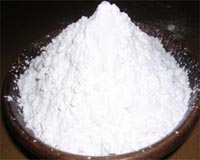Polysaccharides
The polysaccharides include cellulose and starch. Macromolecules of these substances (C6H10O5)n consist of related to each other residues of glucose and differ from each other only in structure of the monomer link, from which chain was "woven". The starch starting material is A-glucose and cellulose is B-glucose.
Starch

Starch is formed in plants from glucose. It is like energy reserve of plants, wtat can easily be converted back to glucose. It accumulates in cereal seeds and potato tubers in the form of pellets of size 2-180 microns. The composition of starch is heterogeneous: 20% consists of amylose (connected in a long chain of 1000-6000 residues of A-glucose) and 80% amylopectin (branched polymer containing about 6000 residues of A-glucose). The amylose macromolecule twisted into a helix, and amylopectin have a spherical shape.

Starch insoluble in cold water, however in hot water it easy swells, forms a viscous colloidal solution of starch paste.
A polymer similar in structure to starch but more branched structure is glycogen. It is contained in animal organisms, in particular in the human liver it about 10%. Glycogen is good soluble in hot water and not forms a paste. When lack of food the body begins to use glycogen, splitting it into glucose.
In the hydrolysis of starch gradually break the link between individual fragments of glucose: first, dextrins are formed, representing the fragments of macromolecules of starch, which contain several dozens of residues of glucose, then the disaccharide maltose, and the final product of this reaction is glucose.
The ability of starch good for absorbing moisture - is used in cosmetic products, it is contained in powders and masks (starch from rice and maize).
Only cellulose, although composed of glucose molecules, is not for a person no nutritional value. This is because in the our body (unlike, for example, from ruminant animals) do not produce enzymes that break down macromolecules of cellulose into molecules of glucose.
Oxidation of 1 g of glucose releases about 16 kJ of energy. The same number gives the oxidation of 1 g of sucrose.
Probably, most of us like a sweets. Every day the average person uses approximately 500 g of sucrose (sugar). But this amount of sugar enters to body not in the form of sucrose, and in the form of starch: bread, pasta, noodles, potatoes, etc. With proper and moderate food per day person should consume no more than 75 g of sucrose, which is only 12 to 14 pieces of sugar (they come in a box of "Sugar"), and here also is the sugar that is used at cooking!
(ways of producing cellulose - see what is paper)
What is most sweet
What is most sweet? If You say the sweetest product is food sugar, there is no doubt you're right. Yes, food sugar (or sucrose - 99.9% sugar) is one of the most common and organic substances, which are produced with our industry. The volumes of this product are significantly higher than any other food crop.
Sucrose is used as reference product, if you have to compare other sweet products.
How to track the sweetness of a product? Sensitivity one may not be taken for reference, as many people - so many tastes! Therefore, in such cases there are special Commission of experts, the results of which are analyzed and averaged. Experts, especially experienced people with high taste sensitivity. They can feel the presence of sucrose in the food product, if it is only 0.35 g/l!
But, for example, do bees the sweet honey? Yes, they do, but not so sweet as we feel it! Bees have 1000 times more "blunt" the taste for sweets, for example, even if in 1 liter of solution was dissolved 20 g of sugar (2% solution) - they will never consider such a solution is sweet! So, in the nectar of flowers that feed bees, sucrose is much higher (up to 70%, which is about 1.7 times sweeter than sucrose). Bee even didn't attention to the 2% sugar solution.
As for fructose, it is a natural sugar, in addition, also the sweetest! Fructose is 1.7 times sweeter than sucrose.
Another product is glucose is less sweet than sugar (sucrose) is almost 1.3 times. An interesting fact when obtaining a sweet product can be observed, if in the process of chemical reaction in the sucrose molecule to replace the 3 group -OH (hydroxyl) to atoms Cl (chlorine), the result of this reaction is obtained a chemical substance 2,000 times sweeter than sugar!
About the milk sugar!
Milk sugar - another of the common sugars. It is also called lactose.
Lactose contained in the milk (around 5%). As for sweets lactose, it is almost 3 times less sweet than sucrose.
As you probably know polyols also have sweetish or sweet taste. Thus, among the foods you can find foods that contain sorbitol HOCH2(CHOH)4CH2OH and xylitol HOCH2(CHOH)3CH2OH. They are synthesized in our industry, at the manufacture vitamin C. For sweets they are different: sorbitol - 2 times less sweet than sugar, xylitol - 4 times more sweet. Naturally, alcohol is not sugar! For the assimilation of alcohols, insulin is not required, so people with diabetes, are just such a food!
For women and girls who count calories in food, it will be interesting to know that such sugar does not contain calories!